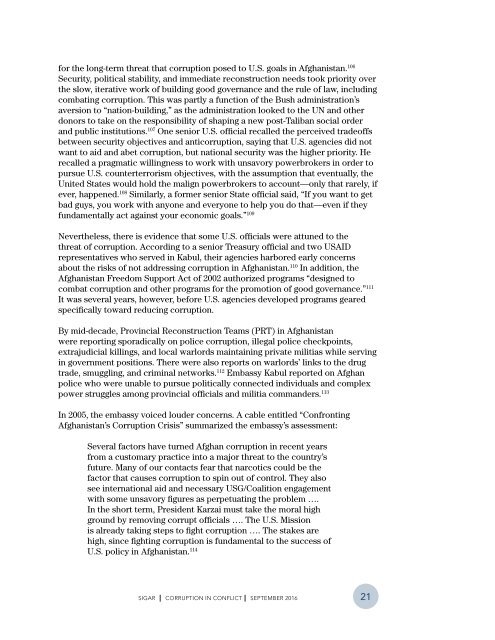CORRUPTION IN CONFLICT
5IlaWjQej
5IlaWjQej
Create successful ePaper yourself
Turn your PDF publications into a flip-book with our unique Google optimized e-Paper software.
for the long-term threat that corruption posed to U.S. goals in Afghanistan. 106<br />
Security, political stability, and immediate reconstruction needs took priority over<br />
the slow, iterative work of building good governance and the rule of law, including<br />
combating corruption. This was partly a function of the Bush administration’s<br />
aversion to “nation-building,” as the administration looked to the UN and other<br />
donors to take on the responsibility of shaping a new post-Taliban social order<br />
and public institutions. 107 One senior U.S. official recalled the perceived tradeoffs<br />
between security objectives and anticorruption, saying that U.S. agencies did not<br />
want to aid and abet corruption, but national security was the higher priority. He<br />
recalled a pragmatic willingness to work with unsavory powerbrokers in order to<br />
pursue U.S. counterterrorism objectives, with the assumption that eventually, the<br />
United States would hold the malign powerbrokers to account—only that rarely, if<br />
ever, happened. 108 Similarly, a former senior State official said, “If you want to get<br />
bad guys, you work with anyone and everyone to help you do that—even if they<br />
fundamentally act against your economic goals.” 109<br />
Nevertheless, there is evidence that some U.S. officials were attuned to the<br />
threat of corruption. According to a senior Treasury official and two USAID<br />
representatives who served in Kabul, their agencies harbored early concerns<br />
about the risks of not addressing corruption in Afghanistan. 110 In addition, the<br />
Afghanistan Freedom Support Act of 2002 authorized programs “designed to<br />
combat corruption and other programs for the promotion of good governance.” 111<br />
It was several years, however, before U.S. agencies developed programs geared<br />
specifically toward reducing corruption.<br />
By mid-decade, Provincial Reconstruction Teams (PRT) in Afghanistan<br />
were reporting sporadically on police corruption, illegal police checkpoints,<br />
extrajudicial killings, and local warlords maintaining private militias while serving<br />
in government positions. There were also reports on warlords’ links to the drug<br />
trade, smuggling, and criminal networks. 112 Embassy Kabul reported on Afghan<br />
police who were unable to pursue politically connected individuals and complex<br />
power struggles among provincial officials and militia commanders. 113<br />
In 2005, the embassy voiced louder concerns. A cable entitled “Confronting<br />
Afghanistan’s Corruption Crisis” summarized the embassy’s assessment:<br />
Several factors have turned Afghan corruption in recent years<br />
from a customary practice into a major threat to the country’s<br />
future. Many of our contacts fear that narcotics could be the<br />
factor that causes corruption to spin out of control. They also<br />
see international aid and necessary USG/Coalition engagement<br />
with some unsavory figures as perpetuating the problem ….<br />
In the short term, President Karzai must take the moral high<br />
ground by removing corrupt officials …. The U.S. Mission<br />
is already taking steps to fight corruption …. The stakes are<br />
high, since fighting corruption is fundamental to the success of<br />
U.S. policy in Afghanistan. 114<br />
SIGAR I <strong>CORRUPTION</strong> <strong>IN</strong> <strong>CONFLICT</strong> I SEPTEMBER 2016<br />
21


